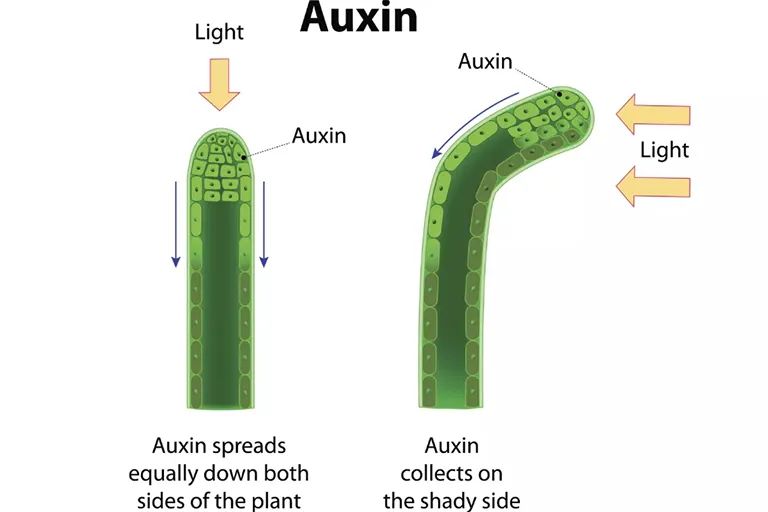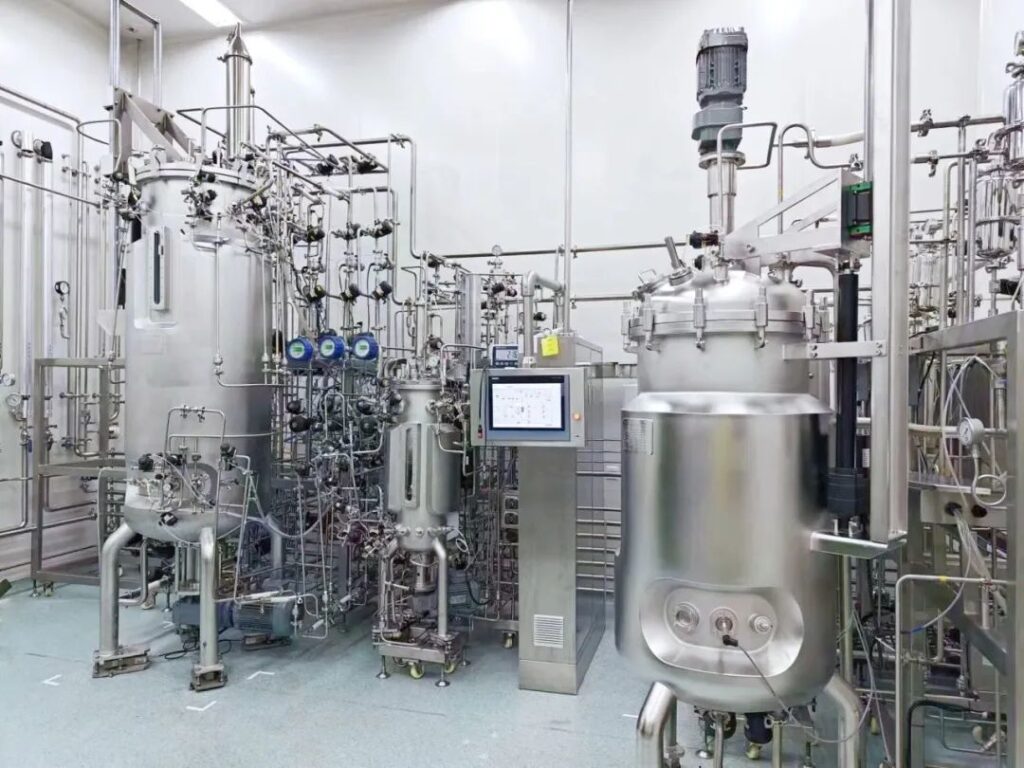Introduction:
Auxin (Auxin), also known as indoleacetic acid, is one of the earliest discovered plant hormones and one of the most widely studied plant hormones, it is a class of endogenous hormones containing an unsaturated aromatic ring and an acetic acid side chain, which plays an important role in the process of plant growth and development.
Auxin is involved in the elongation and division of plant cells, the growth of main and lateral roots and hypocotyls, the formation of plant geotropism and phototropism, and the formation of root hairs and flower organs, which are of great significance for the early growth and development of plants. Auxin not only plays a role in the growth and development of plants and environmental adaptation, but is also an important signaling molecule that coordinates communication between different tissues and even different cells.
So far, five auxin biosynthesis pathways have been proposed, including 5 tryptophan-dependent synthesis pathways and 4 tryptophan-independent pathway. Auxin is found in zucchini, in some cruciferous plants, and in tomatoes. The degradation of auxin, most notably, is easily destroyed by photooxidation under light. Tang Yuwei and J. Banner discovered in 1 that some oxidases in plant tissues can degrade indoleacetic acid, called indole acetic acid oxidase.
Research:
In 1880, C.R. Darwin and his sons, in their last published book, The Ability to Move in Plants, stated that the germ sheath of the Canary grass of the grass family lost its phototropic response when the tip was cut off. His explanation is that when the seedling receives light from the side, the effect of the tip is transmitted downward, causing the growth rate of the light to be different from that of the backlight, which causes the bending to the light receiving side, so that the top does not show a phototropic response after cutting off.
In 1928, F.W. Winter experimentally proved that there was a growth-promoting substance at the tip of the germ sheath, called auxin. It can spread into small agar squares, and placing the resulting small squares back on the side of the cut of the coleoplasty with the tip cut off can cause the coleoplasts to bend to the other side. And the curvature is roughly proportional to the amount of growth-promoting substances it contains. This experiment not only proved the existence of growth-promoting substances, but also created the famous “oat test” for the determination of auxin.
In 1933, F. Kegel isolated indoleacetic acid from human urine and yeast, which can cause the crocolem curvature in the oat test, and proved that indoleacetic acid is auxin, which is commonly found in various plant tissues.

Effect:
The most obvious effect of auxin is to promote growth, but the effect on stem, bud, and root growth varies depending on the concentration. The optimal concentration of the three is stem> bud > root, which is about 10E-5 moles, 10E-8 moles, and 10E-10 moles per liter, respectively. The direction of indoleacetic acid in plants shows obvious polarity, mainly from top to bottom. The apical dominance of inhibiting axillary bud growth in plant growth is closely related to the polar transport and distribution of indoleacetic acid. Auxin also promotes callus formation and induces rooting.
Application:
1.Promotes growth
Auxin (IAA) has a significant effect on the longitudinal growth of vegetative organs. For example, with the increase of concentration, the elongation of the organ increases to the maximum, and the auxin concentration is the optimal concentration, and the elongation of the organ is inhibited if the optimal concentration is exceeded. The optimal concentration of different organs was different, with the stem tip being the highest, the bud being the second, and the root being the lowest. It can be seen that roots are the most sensitive to IAA (auxin), and very low concentrations can promote root growth, and the optimal concentration is 10-10. Stems are less sensitive to IAA than roots, with an optimal concentration of 10-4. The sensitivity of the buds is between the stem and the root, and the optimal concentration is about 10-8. Therefore, the concentration that can promote the growth of the main stem often has an inhibitory effect on the growth of lateral shoots and roots.
2.Promotes differentiation
Auxin can cause cell division in combination with cytokinin, and auxin can also cause cell division alone. For example, in early spring, the resumption of cell division activity in the cambium of trees is caused by the downward transport of auxin produced by the terminal bud.
The most obvious effect of auxin on organ building is in promoting the formation and growth of root primordium. Seedling cuttings produce adventitious roots at their base, which in the case of woody plants are mainly differentiated by new secondary phloem tissues, but can also be formed by the differentiation of other tissues, such as cambium, vascular rays, and pith. Indole butyric acid (IBA) has the best effect in promoting rooting in auxin, and in terms of application, it is found that IBA (indole butyric acid) and naphthalene acetic acid (NAA) are more stable and have better effects than indoleacetic acid (IAA).
3.Sustain your advantage
The stem end of a growing plant has an inhibitory effect on the growth of lateral buds, a phenomenon known as apical dominance. After the apical growth of cotton is controlled with arthrochlor or topping, a large number of lateral buds occur.
4.Suppress out-of-zone
Cotton and fruit trees drop flowers, fruits and leaves are common phenomena in dicots. The shedding of buds in cotton is related to the supply of nutrients and also to hormone levels. When the content of auxin at the base of the bud stalk is high and the content of auxin at the proximal end is low, the activities of cellulase and pectinase in the separation layer are inhibited, so the separation of the separation cells is inhibited, and the bud ring does not fall off. On the contrary, when the content of auxin at the paraxial end is high and the content of auxin at the distal axis is low, the activities of pectinase and cellulase are increased, and the separation of delamination is promoted, resulting in the shedding of bud bells.
5.Promotes firmness
After flowering and fertilization, the auxin content in the ovary increases, which promotes the expansion of the ovary and its surrounding tissues, and accelerates the development of fruits. If the pistil is not fertilized and the ovary can obtain IAA in time, it can also induce the formation of seedless fruits in some plants. If auxin is sprayed or applied to the stigma before pollination, it can eventually develop into parthenocarpic fruit without pollination. Such as pepper, watermelon, tomato, eggplant, holly, zucchini, and figs, etc.
6.Herbicide
There are two types of herbicides:1. Selective herbicide, low concentration to promote plant growth, high concentration to inhibit plant growth, auxin concentration dicots are more sensitive than monocots, so it can be used as a herbicide for monocots in monocots field. 2. Non-selective herbicides: Kill all plants, such as glyphosate.
7.Weightlessness effects
The inward growth of roots and the dorsal growth of stems are induced by the gravitational force of the earth, which is caused by the uneven distribution of auxin under the induction of the gravitational force of the earth. In the state of weightlessness in space, due to the loss of gravity, the growth of stems also loses their back-to-ground properties, and the roots also lose their characteristics of growing to the ground. But the apical advantage of stem growth is still present, and the polar transport of auxin is not affected by gravity.
About BaiLun Biotechnology Co., Ltd
BaiLun Bio is a supplier and technical service provider of whole-set bioreactors (fermenter) and control systems. Our products include bioreactors (fermenter), animal cell bioreactors, bioreactor shakers, biological shakers, bottle rockers, control systems for bioreactors, etc. We can produce bioreactors with different volumes of 0.1L-1000KL and make our contributions for China′s bioreactor business to thrive throughout the world.
BaiLun has a contingent of engineers who have rich experience in fermenting processes, biochemical equipment and chemical technology. In addition, we also invite many nationally famous experts and scholars to act as our technical consultants, so as to ensure that our products have strong and steady technological foundations. The innovation of products and the technology leadership are the core parts of our products. Ensuring customer satisfaction is our permanent pursuit. Taking customer benefit as our own responsibility is the core value of Bailun Company.
Our company offers variety of products which can meet your multifarious demands. We adhere to the management principles of “quality first, customer first and credit-based” since the establishment of the company and always do our best to satisfy potential needs of our customers. Our company is sincerely willing to cooperate with enterprises from all over the world in order to realize a win-win situation since the trend of economic globalization has developed with an irresistible force.
BaiLun spirit: Customer foremost, seeking quality, fairness and honesty, continuous improvement and innovation.
Contact Us:
Add:6848# Liuxiang Rd., Jiading, Shanghai, China
Contact Person: Maddie
Email:[email protected]
Phone:+86-134-7276-8163 (WhatsApp)
Website: https://fermentorchina.com/



